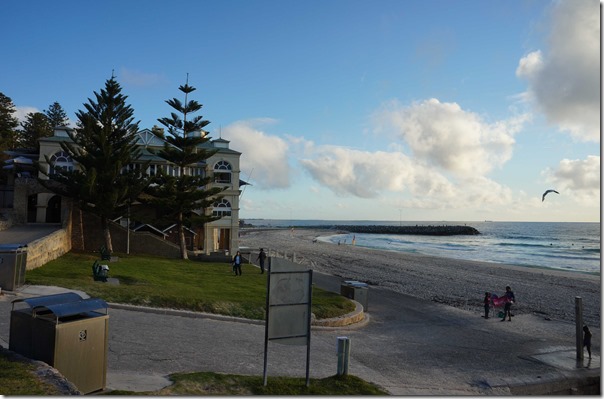
“The view of the sea is so beautiful that words are not necessary.
The music in my mind conjures a poetry of the sea before me”
~ Chopinand, co-author ChopinandMysaucepan on Rachmaninoff’s
Etudes-tableaux Op. 39 no. 2 in A minor
~~~~~~~~O~~~~~~~~
Sergei Rachmaninoff composed two sets of piano etudes called Etudes-tableaux (“study pictures”) arranged under opus numbers 33 and 39.
These “picture pieces of music” were essentially inspired by visual images although Rachmaninoff did not disclose what inspired him to compose each piece. Rather, he said “I don’t believe in the artist that discloses too much of his images. Let them paint for themselves what it most suggests”.
Most recently, I am playing two pieces from the opus 39 suite of nine etudes – the no. 2, nicknamed “The Sea and the Seagulls” and the dark and mysterious the no. 6, nicknamed “The Little Red Riding Hood”.
Both pieces were composed in the key of A minor and needless to say, they elude dark and haunting images.
Today, as I take a leisurely stroll along Cottesloe beach in Perth on this spring evening, I gaze at the Indian Ocean in the horizon. Its beauty is simple yet profound – a setting sun is painting intricate shades of red and gold in the sky. And all the while, a seemingly static image of the sea is changing by the minute.
The view of the sea is so beautiful that words are not necessary. The music in my mind conjures a poetry of the sea before me.
Emotions are evocative and my mind wanders across the land. I believe the raw power of crashing waves juxtaposed against the whispering wind of the sea are images and sounds that inspired some of Rachmaninoff’s music for the piano.
Listen to this beautiful yet haunting etudes-tableaux and journey with me across the ocean.
Rachmaninoff ~ Etudes-tableaux Op.39 No.2 in A minor “The Sea and the Seagulls” performed by Nikolai Lugansky
(Listening tip: Use a good set of headphones)
Note: A Listening Guide & Interpretive Analysis can be downloaded and printed out below for better appreciation of this musical work.

Indiana, Cottesloe beach, Perth, Western Australia

Indiana, Cottesloe beach, Perth, Western Australia

Sunset at Cottesloe beach, Perth, Western Australia

Sunset at Cottesloe beach, Perth, Western Australia

Sunset at Cottesloe beach, Perth, Western Australia

Sunset at Cottesloe beach, Perth, Western Australia

Sunset at Cottesloe beach, Perth, Western Australia

Handprints along a pathway, Cottesloe beach, Perth, Western Australia

Handprints along a pathway, Cottesloe beach, Perth, Western Australia

Park bench at Cottesloe beach, Perth, Western Australia

Footpath onto Cottesloe beach, Perth, Western Australia

Sunset at Cottesloe beach, Perth, Western Australia

Sunset at Cottesloe beach, Perth, Western Australia

Pine trees, Cottesloe beach, Perth, Western Australia

Sunset at Cottesloe beach, Perth, Western Australia

Sunset at Cottesloe beach, Perth, Western Australia

Sunset at Cottesloe beach, Perth, Western Australia

Sunset at Cottesloe beach, Perth, Western Australia

Sunset at Cottesloe beach, Perth, Western Australia

Sunset at Cottesloe beach, Perth, Western Australia

Sunset at Cottesloe beach, Perth, Western Australia

Sunset at Cottesloe beach, Perth, Western Australia

Sunset at Cottesloe beach, Perth, Western Australia

Sunset at Cottesloe beach, Perth, Western Australia
Technique & tips for playing this piece
Composed in the brooding key of A minor and in triple time, the musical directive is lento assai, meaning ‘very slowly’.
Probably the easiest of the nine pieces in the Opus 39 set, it is still by no means an easy piece in itself to play well. It requires a sensitive interpretation by varying tempo and volume to avoid monotony due to the triplets of the left hand recurring throughout the entire piece.
Timing difficulty may be encountered through the 2-beat melody of the right hand over the 3-beat left hand accompaniment. There are also constant right hand over left to play and establish bass notes. Good pedaling technique is also required to elicit a melodic line that is sometimes played pianissimo.

Right hand thirds and augmented fourths and left hand descending chromatic scale
But with some persistent practice and determination, I believe this piece is not as difficult as it may first seem. When it all finally comes together, the satisfaction and joy of being able to play this piece well is immense and deeply rewarding.
I like to share with you some tips from my own experience in studying this piece.
- First practice by familiarizing the melody notes occurring after the second note of the triplets played by the left hand. Once you get the feel of this rhythm, the piece suddenly becomes ‘easier’ as this ‘2 on 3’ rhythm is recurring throughout the entire piece.
- Pay special attention to the phrasing of the left hand. The phrase marks indicate the passage should be played legato. When this is done effectively, not only will the subtle melody be accentuated, the counter melody made up of the first notes of the triplets played by the left hand begin to appear by supporting and harmonizing the melodic line.
- Using the correct fingering from the start is important because this piece demands a legato style of playing and there are some fairly big leaps in arpeggios for the left hand. Good fingering work ensures a good technique to express this piece effectively.
- Try to memorize all seven pages of the entire piece right from the beginning. Once you are able to play without the music score, concentrate on playing the piece very slowly and with minimal mistakes. Once your are thoroughly familiar playing without music only should you begin to contemplate interpreting expression and developing a style of your own.
- The most difficult part of the piece is the middle section beginning with the C sharp minor chord. Break up this section into smaller and distinctive passages that you are comfortable with. Then practice each passage separately until you are familiar playing without the score. This learning process is far easier, let alone faster, than practising this section in its entirety.

Embedded melodic motif of the left hand highlighted in yellow
The music score for this piece can be downloaded from the International Music Score Library Project (IMSLP) by clicking here.
Etudes-tableaux Op.39 No.2 in A minor “The Sea and the Seagulls”
by Sergei Rachmaninoff (1873 – 1943)
Listening Guide & Interpretive Analysis
This Listening Guide and Interpretive Analysis are cross-referenced with the video above of Nikolai Lugansky’s interpretation of Etudes-tableaux Op.39 No.2 in A minor “The Sea and the Seagulls”. It is intended to provide readers with a deeper appreciation of this musical work.
Happy listening and please use a good set of headphones for maximum listening pleasure!
~~~~~~~~O~~~~~~~~

Opening passage: Rachmaninoff's Etude Tableaux Op. 39 No. 2 in A minor
The slow, recurring triplets in the left hand evoke wave-like sound and movement of the sea (0:12). The lento assai directive demands a sensitive approach while the moody key of A minor sets a sad and tragic tone from the beginning.
There are no less than ten sections throughout the piece where diminuendos suggest solemness and resignation. Coupled with poco crescendos, the changing volume brings about a sense of random unpredictability that is constantly threatening.
What begins with calm serenity eventually builds its force through a series of modulations from A minor, G minor (1:19), F major (2:10) and C major (2:33) to a thundering climax of a first huge wave crashing down in octave chords in the key of C sharp minor played by both hands (2:54).
A passage of alternate intervals of thirds and augmented fourths played by the right hand (from 2:55) depicts the shrieking cry of seagulls in a feeding frenzy while waves retreat with the left hand’s descending chromatic scale.
A second thundering wave crashes down in the key of D minor (3:14) and again, seagulls are heard with the right hand while the left hand chromatic scale paints images of receding waves (from 3:15).
This looming mood of uneasiness continues with Rachmaninoff’s trademark sub-melodies and embedded motifs played by the left hand (from 3:21 to 3:42). This tenor voice of the left hand alternates between major and minor tones for twelve whole bars, offering light amidst darkness, hope amidst sadness. The angry yet melancholic voice of the sea eventually subsides into quiet contemplation, in the key of E major (3;42).
The clever use of accidentals in the ensuing passage creates dischord and conflict that is struggling to resolve (from 3:57 to 4:28). A sense of calm and resolution is eventually restored with the home key of A minor (4:29). By this time, the seagulls have gone away. And the angry sea is no longer angry. It is finding peace and solitude (from 4:48 to 5:10).
However, there is sadness still. The sea suddenly yearns and calls out for the pesky seagulls, pleading for them to return (from 5:20 to 5:40). There are dark clouds and anxiety until a G major chord in the antepenultimate bar (6:29) offers momentary rays of sunlight and hope.
But the darkness of the home key brings the piece to a poetic and tragic end.
So dear readers, did you find the listening guide helpful in understanding this beautiful work by Rachmaninoff?
Indiana, Cottesloe Beach
99 Marine Parade, Cottesloe
Western Australia
Tel: +61 8 9385 5005
Opening hours: Lunch and dinner Mondays to Sundays














































































































Stunning shots of the beaches!
i was just there over the weekend! i sat there well after last light and enjoyed the sound of the ocean. simply beautiful!
Wow what a view! Have yet to visit WA but hopefully will sometime soon!
Such amazing photos!!
So peaceful and relaxing, fantastic story.
Just beautiful!
I came for the sunset and stayed for the music. Both were incredibly beautiful. Thank you for sharing the listening guide, too.
Dear Kim,
Sometimes, I am in two minds with a listening guide. On the one hand, it could be useful for listeners who are not familiar with the piece of music.
However, the images and interpretative emotions are ones which I see and feel personally and other listeners may see or feel differently and the last thing I want for a listening guide is to ‘cloud’ their imagination with my own feelings.
Once again thank you for making me stop and take a few mins out of my day to listen to some “proper” music. Very enjoyable! I also agree this rhythm is not as difficult as it seems at first…in fact that is the exact term with a word game I use for my students when first attempting the 2-3 beat….to learn it, (no matter what time signature you ultimately finish playing in), by using your left hand to clap out a 3/4 beat and saying “Not-diff-I-cult” , this will give you the four sounds needed, with right and left hands combined on the “not” followed by L R L with the words diff-I-cult (right hand falling on the -I-)…. Looking forward to the next recording!
Looking forward to the next recording!
Dear Corrie,
I’m glad you enjoyed this beautiful piece of music.
Your technique is certainly a useful way to tackle poly-rhythms. My own method that I find effective is to use a colour highlighter to highlight the notes of the right hand that occurs immediately after the rhythm beat of the left hand. The highlighted note is a signal for the right hand ‘to act’
I found this method particularly effective when learning Rachmaninoff’s prelude in G major where the left hand plays quintuplets for almost the entire piece.
http://chopinandmysaucepan.com/rachmaninoff-prelude-in-g-major-opus-32-no-5